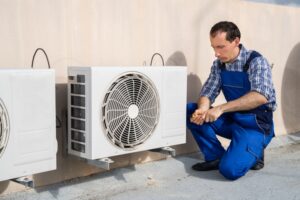When weather forecasts of impending hurricanes start to surface, the first thing we have to think about is making sure our family, friends, and neighbors are going to be safe. Of course, another aspect of responsible home ownership is preparing our houses for the battle.
In South Florida we’re used to the necessary precautions that need to be taken when severe weather is imminent. The hurricanes are bad enough, we don’t need to spend thousands of dollars in repairs that could have been avoided with some relatively minor prep work.
One home feature where this is very prevalent is with the hurricane preparation guide for residential air conditioning systems.
Is Your Air Conditioner Hurricane-Safe?
The outdoor components of your air conditioner are some of the most vulnerable when high winds and torrential rains threaten to strike. The condensing unit is housed outside your home and contains some of the most expensive components of your entire AC system. These parts can become easily damaged by flying debris, flood waters, lightning, hail, and more.
When the storm finally does subside, you want to be able to be cool and comfortable as you put your home back together which is why this hurricane preparation guide for residential air conditioning systems is so important.
Step One – Tie Down Straps
It’s important to note that most of the tips in the hurricane preparation guide for residential air conditioning systems are not done as optional – they’re mandatory as part of our local code. The use of tie down straps to fasten your outdoor condensing units to the concrete slab below are done as much to prevent damage to it as they are to prevent the safety concerns that come from a flying AC. Your neighbors have enough to worry about with potential 100+ MPH winds, they don’t need 150 pounds of metal flying around.
Tie down straps are mandatory in Florida and they help provide wind resistance up to 150 MPH. Tie down straps can come in the form of metal brackets, nylon straps or cable ties to name a few. Their main job is to create an anchor between the condenser unit and the support slab below.
Tarps and Other Barriers
Outdoor condenser units are built to withstand water exposure from rain but it still helps to limit the amount of moisture and debris that actually do enter into the system. Tarps or some sort of other hard protective covering will help create a barrier between the wind/rain and these sensitive electrical components.
Electrical Prep
Besides wind, rain, and hail another threat that must be addressed in the hurricane prep guide for central air conditioning systems is lightning. A strike of lightning can fry your system components requiring a complete AC replacement. Before a hurricane approaches you should turn off the air conditioner at both the thermostat as well as the circuit breaker.
True Safety Continues After the Storm
The hurricane prep guide for central air conditioning systems should also include a very thorough inspection of the system after the storm has passed. Before you even turn the system back on, make sure to give us a call to avoid any issues that may have arisen during the storm.
We will search for leaks, frayed wires, damage from flying debris, and burn marks to make sure your air conditioner does not misfire on start-up.
Hurricane Prep Guide For Central Air Conditioning Systems Summary
In summary, you should tie your AC down with straps before the storm, protect it with a tarp or plywood during, and make sure to be vigilant in inspecting the damage afterward. If your split AC system lacks hurricane straps or you just want to make sure you’re as protected as possible in the wake of potential storms give us a call today.






